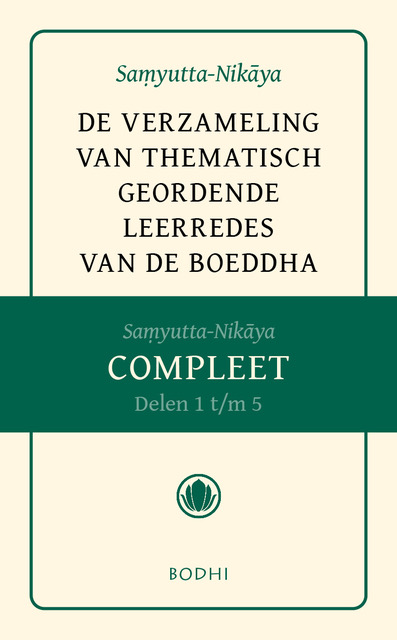This series contains all of the five volumes of the integral Dutch translation of the Samyutta-Nikaya, ‘The Connected Discourses of the Buddha’.
The Samyutta-Nikaya is traditionally seen as the third set (nikaya) in the Sutta-Pitaka, after the Digha-Nikaya and the Majjhima-Nikaya. The Sutta-Pitaka is the ‘basket’ of discourses (sutta’s) attributed to the historical Buddha and his main disciples.
The Sutta-Pitaka is part of the Pali-Canon together with the Vinaya-Pitaka (the ‘basket’ of the monastic rules) and the Abhidhamma-Pitaka (the ‘basket’ with detailed scholastic presentations of doctrinal material). Together they form the body of sacred texts of Theravada Buddhism. The Pali-Canon or Tipitaka (‘three baskets’) contain the oldest extant scriptures of the Buddhist tradition.
The Samyutta-Nikaya contains 2904 suttas, divided into 56 books (samyuttas), each of which deals with a particular theme. In the many, often very short, suttas of the Samyutta-Nikaya, the Buddha’s radical insights into human nature are presented and his unique path to spiritual liberation from suffering in this world is shown.
The first volume of the Samyutta-Nikaya (Sagatha-Vaga) consists mainly of verses and is considered one of the most inspiring compilations in the Pali Canon. The subject matter is mainly ethical and most suttas deal with the Buddhist ideal of life.
The second volume is the Book of Causes (Nidana-Vagga) and contains 10 ‘books’ or samyutta’s
The third volume, the Khandha-Vagga, ‘The Book of the Aggregates’, contains 13 books. The thread that runs through this volume is the ‘five aggregates of the personality’ (pañca khandha). The first and longest book is entirely devoted to this. Three smaller books (23, 24 and 33) are also devoted to it. The other nine books deal with four themes: the ten ways of describing sensory experiences, the nine stages of meditation, karma and the skills needed to achieve concentration. In books 28 and 33 we also learn something about the personalities of two important disciples of the Buddha, Sariputta and Vacchagotta.
In the fourth volume, the Salayatana-Vagga, ‘The Volume of the Six Sense Fields’, 10 books are included. The name is derived from the first book of this volume: ‘The Book of the Six Sense Fields’. As with the two preceding volumes, this volume is dominated by the first book, which occupies about half of it. The importance of the six sense realms is shown by the fact that in the first book the Buddha calls them ‘the all’, thereby indicating that the entire human experience can be traced back to these six realms. The complete understanding of the structure of experience leads to salvation from suffering. The second book of this volume, ‘The Book of Feelings’, forms a logical sequence. The other eight books deal with other themes.
In the fifth volume, the Maha-Vagga, ‘The Great Volume’, there are 12 books. This Volume is called “The Great Volume” because it is the largest volume of the Samyutta-Nikaya in terms of size. It is probably also called “great” because it contains the core of the Buddha’s teaching. This is because the first seven books are devoted to the ’37 factors of enlightenment’: the four ways of cultivating mindfulness, the four right efforts, the four bases of magical power, the five mental faculties, the five powers, the seven factors of enlightenment and the Noble Eightfold Path. The other five books contain suttas on the monk Anuruddha, the four stages of meditation-practice, attentive in-and-out-breathing , entering the stream and the Four Noble Truths.
